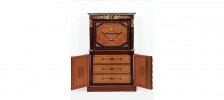Cabinet and bureau
Pierre-Etienne Levasseur et Levasseur Jeune
Possibly Pierre-François-Henri Levasseur (1764-1841)
Circa 1806-1807
Teak and boxwood incrusted with tortoise-shell, nacre, lapis-lazuli, pewter and coral; gilt bronze, blue turquoise marble
H. 100 m; W. 132 m; D. 56 m
Inv. 873, donation Lapeyre
The purchase of these pieces of furniture in 1978 by Martial Lapeyre led to the entry into the collection of the Fondation Napoléon of some extraordinary exemples of French cabinet making, worthy of the finest museums.This remarkable piece of furniture has been identified as a result of the double sale made to the Crown furniture store (Garde-Meuble de la Couronne) by the cabinet-maker Levasseur, firstly in 1823, and latterly in 1826. Here the vendor noted that this cabinet and matching bureau had been « made fifteen years earlier for the Prince of Peace », in other words Manuel Godoy (1767-1851), the favorite of the Spanish king Charles IV and lover of the Queen, née Marie-Louise de Bourbon-Parme. Godoy’s rise was exceedingly rapid: initially entitled Prince of Peace in 1795 because of his role in bringing about the honourable peace with the French revolutionary government, the Convention, he married in 1797 a grand-daughter of king Philip V and finished his career in 1807 as Admiral General of Spain and the Indies, with the title, ‘Your Highness’. It would appear that Godoy commissioned these two pieces of furniture before the events in Bayonne, during which the Spanish crown passed to Joseph Bonaparte, because in September 1808 he was once again a mere private individual, following the sovereigns into exile, first to the Château Saint-Joseph near Marseilles, and later to Rome.
Since they are very close structurally to certain works by Jacob-Desmalter, such as for example the bureau known as the ‘secrétaire de Bordeaux’ (Musée du Louvre), these pieces of furniture would appear to date from the years 1806-1807. Their sumptuous incrustations, particularly unusual for French furniture of the period, is reminiscent of decoration produced by Percier and Fontaine for the Spanish market, such as for example the sides of the cabinet ‘de platine de la casa del Labrador’ at the Palace in Aranjuez. It is likely that exile prevented Godoy from receiving his order and that the cabinet and bureau stayed in Levasseur’s workshop. It is known that he tried in vain to sell them for 6,000 francs, first in February 1823, and then in May 1826. Despite the fact that they were at the time considered « very handsome and well made », the Crown furniture store found the price too high and gave up the idea of acquiring them. When Levasseur’s workshop closed in 1841, they were put up for sale, and their real origin seems to have been forgotten; people were talking about a commission by queen Isabelle of Spain, but since she was born in 1830, she could only have been 11 at the time of the sale! Unless the documents refer to the second wife of Isabelle’s father, Ferdinand VII, namely the queen Marie-Isabelle, born the infanta of Portugal (1797-1818).
Photographs © Fondation Napoléon- Patrice Maurin-Berthier












